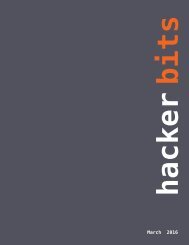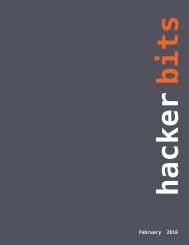Hacker Bits, August 2016
HACKER BITS is the monthly magazine that gives you the hottest technology stories crowdsourced by the readers of Hacker News. We select from the top voted stories and publish them in an easy-to-read magazine format. Get HACKER BITS delivered to your inbox every month! For more, visit https://hackerbits.com/2016-08.
HACKER BITS is the monthly magazine that gives you the hottest technology stories crowdsourced by the readers of Hacker News. We select from the top voted stories and publish them in an easy-to-read magazine format.
Get HACKER BITS delivered to your inbox every month! For more, visit https://hackerbits.com/2016-08.
You also want an ePaper? Increase the reach of your titles
YUMPU automatically turns print PDFs into web optimized ePapers that Google loves.
We also need to transform the<br />
descriptions into something<br />
the machine understands,<br />
which is numbers.<br />
ops leading edge business<br />
solutions for the global<br />
insurance industry.<br />
RegExp<br />
The first thing we do is to use<br />
regular expressions to get rid of<br />
non-alphabetical characters, as<br />
our model will only be able to<br />
learn words.<br />
description = re.sub(“[^azA-Z]”,<br />
“ “, description)<br />
After removing non-alphabetical<br />
characters:<br />
Leading provider of business<br />
solutions for the global<br />
insurance industry TIA<br />
Technology A S is a software<br />
company that develops<br />
leading edge business<br />
solutions for the global<br />
insurance industry<br />
Stemmer<br />
We also stem the words. This<br />
means reducing multiple variations<br />
of the same word to its<br />
stem. So instead of accepting<br />
words like manufacturer, manufaction,<br />
manufactured & manufactoring,<br />
we rather simplify<br />
them to manufact.<br />
from nltk.stem.snowball<br />
import SnowballStemmer<br />
stemmer =<br />
SnowballStemmer(‘english’)<br />
description =<br />
getDescription()<br />
description = [stemmer.<br />
stem(word) for word in<br />
description]<br />
After stemming the words:<br />
lead provid of busi solut<br />
for the global insur industri<br />
tia technolog a s is<br />
a softwar compani that<br />
develop lead edg busi solut<br />
for the global insur industri<br />
Stop words<br />
We then remove stop words,<br />
using Natural Language Toolkit.<br />
Stop words are words that have<br />
little relevance for the conceptual<br />
understanding of the text,<br />
such as is, to, for, at, I, it, etc.<br />
from nltk.corpus import stopwords<br />
stopWords = set(stopwords.<br />
words('english'))<br />
description =<br />
getDescription()<br />
description = [word for word<br />
in description if not word in<br />
stopWords]<br />
After removing stop words:<br />
lead provid busi solut<br />
global insur industri tia<br />
technolog softwar compani<br />
develop lead edg busi solut<br />
global insur industri<br />
Transforming the<br />
data<br />
But cleaning and stemming<br />
the data won’t actually help us<br />
do any machine learning, as<br />
we also need to transform the<br />
descriptions into something the<br />
machine understands, which is<br />
numbers.<br />
Bag of Words<br />
For this, we’re using the Bag of<br />
Words (BoW) approach. If you’re<br />
not familiar with BoW, I’d recommend<br />
you read this Kaggle<br />
tutorial.<br />
BoW is a simple technique to<br />
turn text phrases into vectors,<br />
where each item in the vectors<br />
represents a specific word. Scikit<br />
learn’s CountVectorizer gives<br />
you a super simple way to do<br />
this:<br />
hacker bits<br />
51















